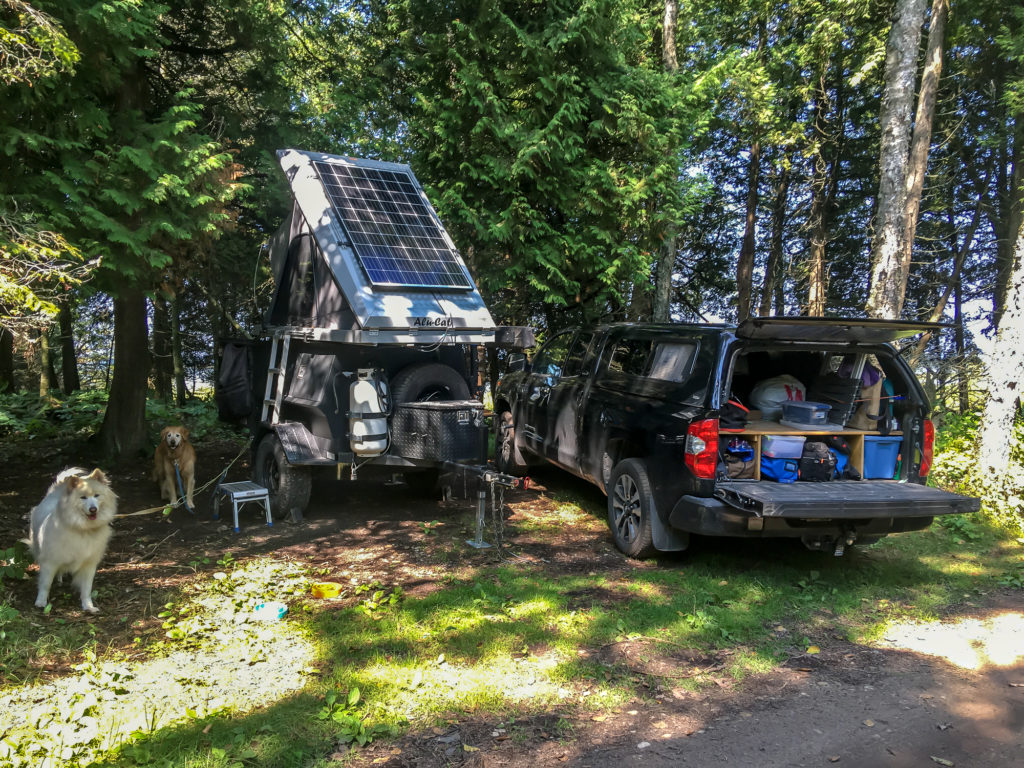Flash and Boom
CRASH, BOOM, CRACKLE. Those are the sounds I heard last night after waking up to a series of flashes outside our tent. I am likely being a bit dramatic for literary emphasis, but, regardless, waking up to lightning in the distance is A) something I am not commonly used to in Washington State, and B) definitely not something I am used to while sitting in a tent, perched 6’ above the ground.
The irony is that last night’s storm was about half as severe as the lightning storm we experienced when camping with family a few days ago. The primary difference was that I could see last night’s lightning, whereas the earlier storm’s lightning was blocked on my side of the tent. Which probably explains why, at 1:30AM, Leah was somewhat annoyed by my sitting up in bed and saying, “Leah… Leah… I think a storm is coming. Maybe we should go sit in the truck for a while?”.
Edit added by Leah based on her recollection of actual events:
- Andy: “Leah… Leah… *sigh*… are you awake?”
- Leah: “rrrmmmm”.
- Andy: “Can you see the lightning?”
- Leah: “rrrrmmmm”.
- Andy: “I think it’s getting closer”.
- Leah: “rrrrmmmm”.
- Andy: “ Do you think we should go in the truck?”
- Leah: “rrrmMMM…” I was sleeping…. rrrmmmm… It doesn’t seem that bad.”.
- Andy: “I think I’m going to go in the truck”.
- Leah: “mrrmMMMmm…. arghh… fine. I’m awake now anyway.”.
Nonetheless, we got up and sat in the truck. The storm never did pass directly over us, although lightning flashed once a second for about an hour. We returned to the tent at about 3AM, but it was, needless to say, not our best night’s sleep.
Since this was a relatively minor storm, and we are headed further east, where stormy weather is especially prevalent this year, we are definitely going to have to figure out how best to survive in a tent in adverse weather!
We haven’t solved it yet, but following are a few takeaways after further research and contemplation, which you conveniently have ample time to do when sitting in a truck for a couple hours in the middle of the night ![]() .
.
1) Make sure you are not the tallest object around. This is kind of obvious, but it is a lot safer when you are sheltered by trees! (This assumes wind is not also something to consider, in which case it is important to be cognizant of falling limbs or trees).
2) Check the weather in advance. It helps to know where a storm may be coming from, what the potential severity is, and what the probability of a storm is. I personally find most weather sites to be a bit too ambiguous, and thus mostly use digital.weather.gov. I usually observe Wind Speed/direction, probability of precipitation, and amount of precipitation to observe the size, location, and speed of a potential weather system.
3) Know where safe zones exist. In lightning, a car or truck is considered to be one of the safer spots. The car acts as a Faraday cage, and should prevent bodily harm from lightning. It is inconclusive to us whether an aluminum hardshell roof top tent would equally suffice as a Faraday cage, but I think it probably would since the fabric walls are partially conductive (?). This item also includes having a backup plan in case weather gets really bad. Ie. if the storm is worse than expected, where will you go?
4) Use common sense! If you can, avoid the storm entirely ![]() . The nice thing about mobile living is that you should be able to mostly avoid any major storm systems. Also included in common sense is avoiding areas with huge storm clouds building overhead, or camping in a beautiful area with surprisingly very few campers around.
. The nice thing about mobile living is that you should be able to mostly avoid any major storm systems. Also included in common sense is avoiding areas with huge storm clouds building overhead, or camping in a beautiful area with surprisingly very few campers around.
I am probably extra cautious because I have been scared of being shocked ever since I took a science experiment too far in the eighth grade ![]() . Either way, I’d say our scenario last night would have been better if A) I had just relaxed a bit and enjoyed the moment, and B) prepared a bit more for the possibility of a storm coming in.
. Either way, I’d say our scenario last night would have been better if A) I had just relaxed a bit and enjoyed the moment, and B) prepared a bit more for the possibility of a storm coming in.
At the end of the day, lightning is a very minor threat statistically. It is loud and flashy, which makes it seem a lot more scary than it really needs to be (especially at 1:30AM!). It does demand respect since it is unpredictable and destructively powerful, but it can be safely managed with some caution and prudence.
I have yet to take any pictures of a storm when its happening, but the following pictures at least highlight the pleasant nature of our campsite and nearby lighthouse before the evening’s excitement.

